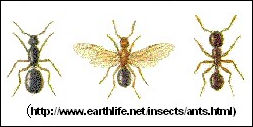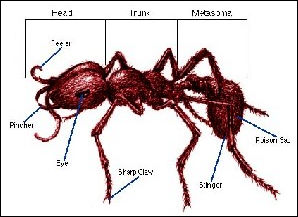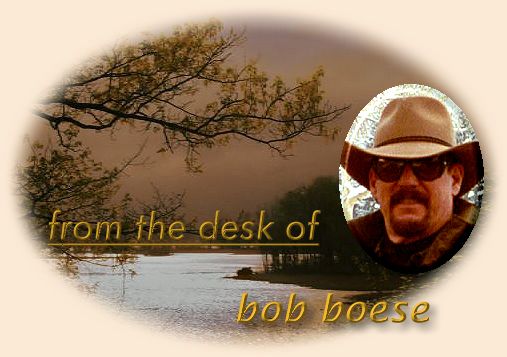
| ||
|
October 6th, 2008
|
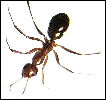
GENERIC FLOATING ANT PATTERN
Thread: Black or red flat waxed nylon. Body: Fun foam (red and/or black). Legs: Black or red (badger) dry fly hackle Wing: (optional) poly yarn. 1. Wrap a layer of thread from hook eye to bend and back toward the eye 1/4 of the shaft length. 2. Cut a strip of red or black (or both) foam 1/16th inch wide and trim to point at one end. (It doesn't matter how long the strip is, any remainder can be reused on another ant.) 3. Tie in the point (of red or black) of the foam strip with the strip extending over the hook bend. 4. Wrap thread over the foam to the bend (tightly) and bring the thread back to the middle of the hook shaft. 5. Bend the foam over the thread wraps toward the hook eye and tack down with thread at the middle then wrap thread up to near the hook eye. If you want a red-butt ant (red rear with black front) cut off excess red foam and tie in black at the middle with foam strip extending over the eye. 6. Move thread back to middle of shaft. 7. Bend foam (the part extending over the hook eye) back toward hook bend and tack with thread wrap in the middle of the shaft. 8. Trim excess foam and cover trimmed end with thread. 9. Coat entire fly with Hard As Nails (2 coats). 10a. Optional wings – tie in a small sparse clump of poly yarn toward the hook bend. 10b. Tie in dry fly hackle and wrap 4-6 times in middle of thread covered area between two folded foam ovals. 11. Tie off hackle and whip finish at middle of fly. Coat the entire fly with some floatant.
GENERIC SINKING ANT PATTERN
Thread: Black or red flat waxed nylon. Body: Thread. Legs: None or very sparse black or rust partridge hackle. 1. Wrap a layer of thread from hook eye to bend. 2. Overwrap thread on shaft above hook point to form an oval ball. 3. Bring thread toward eye and form another overwrap ball behind the eye. 4. Coat entire fly with Hard As Nails (2 coats). To add legs: 5. Move thread back to middle gap between the two thread balls. 6. Tie in a hackle and wrap 2-3 times. 7. Tie off the hackle and whip finish at middle of fly.
ORGENERIC 2 TONE SOFT HACKLE ANT 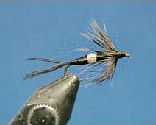
Thread: Black and white flat waxed nylon. Body: Thread. Legs: Black partridge hackle. 1. Wrap a layer of black thread from hook eye to hook bend. 2. Tie in a few barbs of soft hackle to form a tail. 3. Bring thread toward eye and let bobbin hang. 4. Tie in white thread at center of hook shank and make a white segment then tie off there. 5. Tie in a hackle behind hook eye and wrap 2-3 times. 6. Tie off the hackle and whip finish. 7. Coat thread with Hard-As-Nails. ~ Bob
About Bob:Robert Lamar Boese has fly fished for five decades. He is an environmental negotiator, attorney and educator who has provided environmental legal services for more than thirty-three years including active duty with the U.S. Coast Guard and Department of Justice. He is a well known fly tyer with several unique patterns to his credit. He has developed and authored federal and state regulatory programs encompassing a broad spectrum of environmental disciplines, has litigated environmental matters at all levels of the federal and state court systems, and is a qualified expert for testimony in environmental law. He has authored over 60 published text chapters, comments or articles on environmental matters, is a member of the Colorado, District of Columbia and Louisiana Bar Associations, and is a certified mediator. In addition to his legal practice, Mr. Boese has been a high school teacher, an associate professor of Environmental Law and Public Health, has authored numerous fiction and sports publications, and is a softball coach and nationally certified volleyball referee. He is the president of the Acadiana Fly Rodders in Lafayette, Louisiana and editor of Acadiana on the Fly. He has been married for thirty years and is the father of two fly fishing girls (25 and 21). For additional information contact: Boese Environmental Law, 103 Riviera Court, Broussard, LA 70518 or call 337.856.7890 or email coachbob@ymail.com.
|
If you would like to comment on this or any other article please feel free to
post your views on the FAOL Bulletin Board!

|
